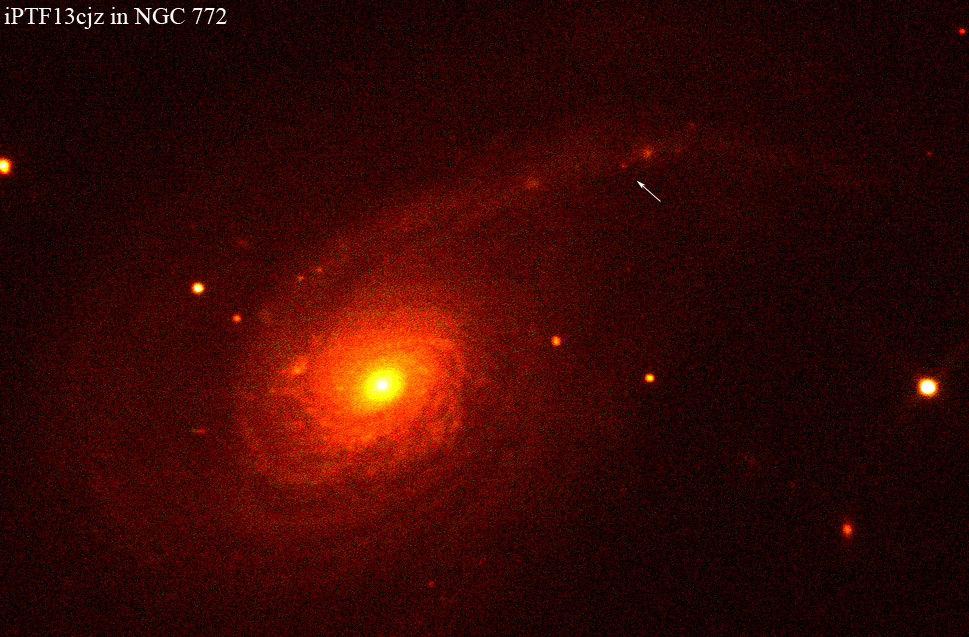NGC 772Taken By: Samara3 When taken: Oct 2, 2013 14:20:15 UTC RA: 1h59'15" DEC: 19°01'34" Filter: RGB Exposure time: 300 secs. 14:21:59 UTC RA: 1h59'15" DEC: 19°01'34" Filter: Bessell-I Exposure time: 40 secs. 14:27:59 UTC RA: 1h59'15" DEC: 19°01'34" Filter: Bessell B Exposure time: 300 secs. PSN J01591443+1901339 (= iPTF13cjz)CBAT TOCP discovered 2013/07/26.450 by Lick Observatory Supernova Search Found in NGC 772 at R.A. = 01h59m14s.43, Decl. = +19°01'33".9 Located 73" west and 67" north of the center of NGC 772 (Discovery image) (Koichi Itagaki image) (S. Leonini, G. Guerrini, P. Rosi and L.M. Tinjaca Ramirez image) (William Wiethoff image) (Emmanuel Conseil image) (Juan-Luis Glez. Carballo image) (Emile Capella image) Mag 19.1:7/26, Type LRV (References: ATEL 5272, SN 2003ip 2003hl) Discovery of an intermediate luminosity transient iPTF13cjz in NGC 772 ATel #5272; O. Yaron (Weizmann), M. M. Kasliwal (Carnegie/Princeton), S. B. Cenko (NASA/GSFC), Y. Cao, A. Waszczak (Caltech), I. Arcavi, D. Tal (Weizmann), K. Clubb, P. L. Kelly, O. Fox, A. V. Filippenko (UC Berkeley), report on behalf of the iPTF collaboration on 13 Aug 2013; 17:01 UT Distributed as an Instant Email Notice Transients Credential Certification: Mansi Manoj Kasliwal (mansi@astro.caltech.edu) Subjects: Infra-Red, Optical, Supernovae, Transient The intermediate Palomar Transient Factory (ATel#4807) reports the discovery of an optical transient, iPTF13cjz, in the spiral arm of NGC772 (~30.3 Mpc; NED). iPTF13cjz was discovered on 2013 August 02.36 UT at RA(J2000) = 01:59:14.47, DEC(J2000) = +19:01:33.6, at 18.9 mag in the PTF R-band (calibrated wrt SDSS), which corresponds to absolute magnitude of -13.5. A follow-up spectrum was promptly obtained on Aug 02.54 (~2.5 hours from event confirmation) with Keck2-DEIMOS and shows low-velocity P-Cygni profiles, absorption and emission lines of H, HeI, NII and various intermediate-mass and Fe-group elements (OI, NaI, MgI, CaII, FeII). The emission lines resemble those of luminous blue variables(e.g. UGC 2773 OT2009-1; Smith et al. 2010) but the underlying red continuum is more reminiscent of intermediate luminosity red transients (e.g. PTF10fqs; Kasliwal et al. 2011). Moreover, follow-up near-infrared photometry with Reionization and Transients Infrared Camera (RATIR; www.ratir.org) on Aug 10 confirms the red color of R-H = 2.0 mag. We note that this transient was independently discovered by LOSS/KAIT and reported as a TOCP on Aug 12. |
 |